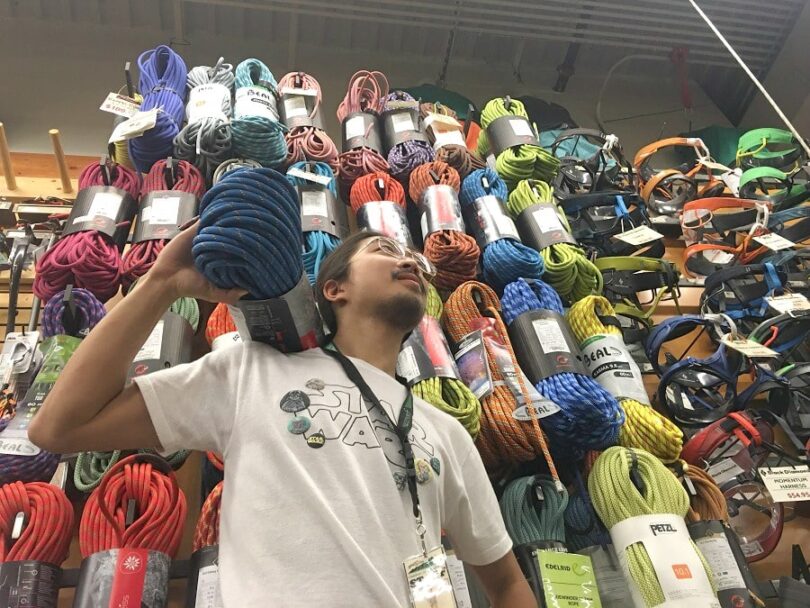The rope is an essential element of any survival kit or outdoors trip baggage. It can come in handy in a surprisingly large number of ways and is guaranteed to make your camping, hike or another adventuring more convenient. As a general rule; you can never have enough rope. We recommend you have at least some of a few different kinds on hand to ensure you’re covered for a variety of situations. From lifesaving river crossing rope to simple stringing rope for washing lines, the rope is an incredibly useful asset to take with you into the great outdoors. But what types of rope for outdoors use should you have stashed up?
In this article, we’ll explain the different kinds of rope and their uses to you so that you can create the ultimate outdoors pack. There is a wide range of rope choices available on the market today, many of which can be purchased both online and offline. We’ll give you a heads up as to what types of rope to buy for your own particular needs and situation. But first, let’s take a look at some of varying and fantastic uses of rope.
Handy Uses of Rope
These are just a few of the many uses that rope can have outdoors. There are dozens more that may come up in day to day situations out in the wild, but we can’t cover them all here. You are limited only by your imagination in terms of how rope can be used.
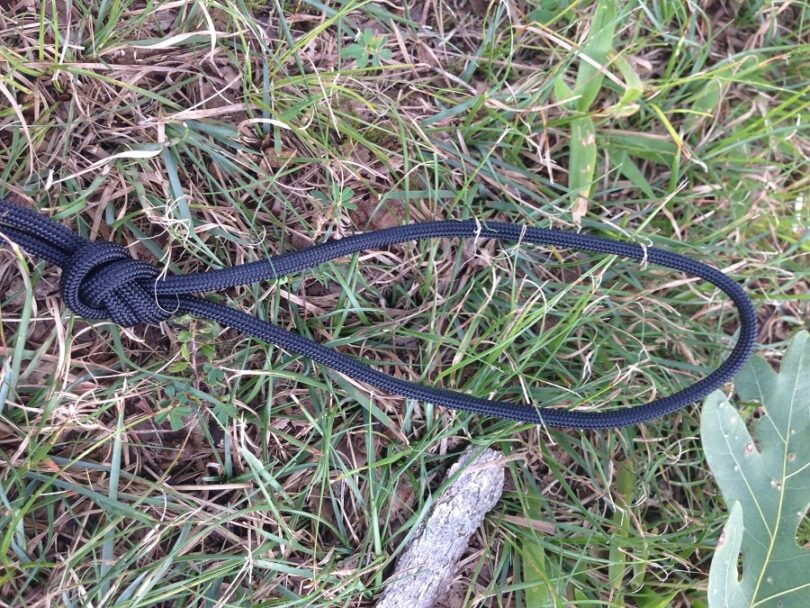
Keeping good rope on hand will add a lot of convenience to your life. Some of the things it can be used for include:
- Building a raft or flotation device
- Creating a trip wire with a noisy can at the end to alert you of trespassers or dangerous animals
- Hanging out for use as a washing line or food line to dry items on
- Rappelling/abseiling down sheer cliffs (this should only be attempted by those who have been properly trained in rappelling and have the right equipment and rope strength)
- Securing your items against strong winds by tying them down
- Makeshift belt or shoelace usage.
- Starting a fire by creating a rope bow drill for friction creation
- Holding together bandages to create a makeshift tourniquet to help stop heavy bleeding
- Hammock making (especially useful if there are insects, snakes or other undesirables crawling around on the ground)
- Fishing net construction from smaller strands
Types of Rope
Now that you understand partly the many uses for and the importance of carrying a rope with you when you go off adventuring in the great outdoors, let’s explore the different types of rope available for you to choose from when stocking up your gear.
We’ve included a wide range of options here as we know there is a wide range of activities you may be interested in using them for. Also, you will learn about rope material properties and use cases for every type of rope described below.
Remember, it’s best to highlight about three or four different kinds that suit your needs (widths, strength, durability, etc.) and keep all of these in your pack for when you need them. Now without further ado, here are the main types of rope available on the market today:
Twisted/Laid Rope
This style of rope is aptly named as it is made up of multiple strands (usually three) twisted together like a spiral. As it’s made from polypropylene wire it is not necessarily the strongest rope out there, but it certainly has its uses.
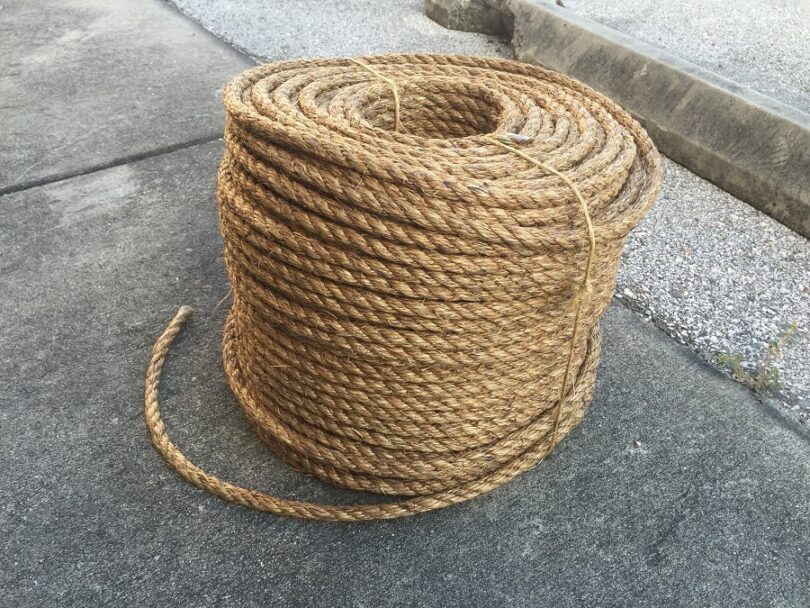
Aside from being very cheap, it also has other upsides, such as being impervious to water and sinking when submerged. Unfortunately, it does rot quickly, though and tends to be on the bulky side. We can recommend using it for fishing nets or fish traps as it works well under water and these are usually re-created quite often so the durability issue shouldn’t matter too much.
Also, it’s cheap, so you could make multiple fishing net traps at once, which is far more successful for catching fish in the wild. The durability does make it unsuitable for true survival situations or long-term use, though. Remember that you get what you pay for in the rope industry, and this is a cheap rope.
Sisal Rope
This natural fiber based rope is fantastic for using as a survival rope. It is made from the Agave sisalana plant which is popular for its stiff fibers and is used for making various ropes, cordage, rugs and other items.
Regular users of this rope are fans because of its relative cheapness and its ability to withstand salt water well – a rarity in rope types. It can be coarse in texture and is considered bulky, so it’s up to you how much the comfort of the rope feel on your hands means to you.
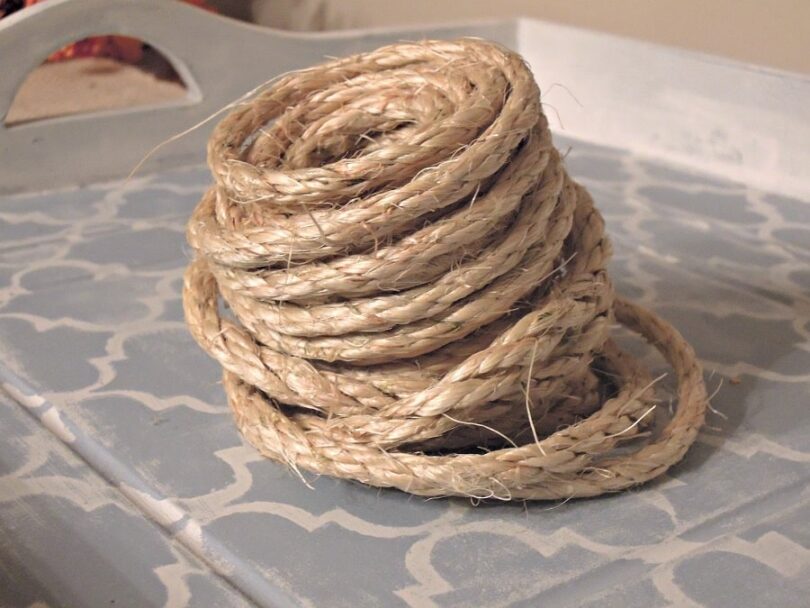
Clearly, it’s not the best option for the rope that you’ll be touching or tugging on a lot, but in terms of securing things, it’s high up there, especially in coastal environments with lots of sea moisture in the air.
A thinner version of Sisal rope is bailing twine. It is often used on farms for things like tying up hay bales because of its superior strength for such thin rope. To be specific, this thinner form of Sisal rope has about 350 pounds of breakage strength, which is very good for a cheap thin rope.
The only downside would still be the typical Sisal rope coarseness on your hands when handling it, and it’s lack of flexibility. Other than that, we’re big fans of the traditional sisal rope weather in it’s in its thick form or it’s bailing twine thin form.
Braided Rope
A fairly strong type of rope, braided rope is commonly used in marine applications. It is created by weaving fiber strands together in either a hollow or double braided form. The reason it is used in marine applications probably has something to do with its strength, which as mentioned is great when it’s relatively new.
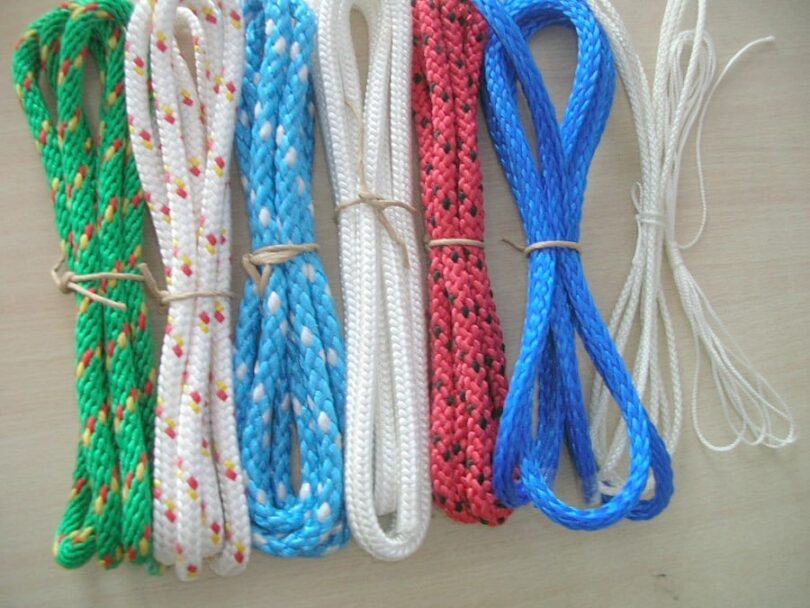
This strength won’t last long though as braided ropes tend to rot quickly. They also usually have some stretching appear over time and don’t generally un-braid well. These latter two factors can be advantageous or disadvantageous, it all depends on what you want to use your rope for.
Climbing/Kernmantle Design Rope
Modern day ropes made for climbing are made in a design called “kernmantle”. This is the same design used to make parachute cords and is extremely strong. The “kern” in “kernmantle” is German for core, and the “mantel” part could be used to describe a jacket.
This makes sense when you look at the structure of the rope which has an inner core made up of many separate strands and then an outer layer which is highly resistant to abrasion. The outer layer helps to make the rope more durable and tear resistant by protecting the inner “core” of the rope.
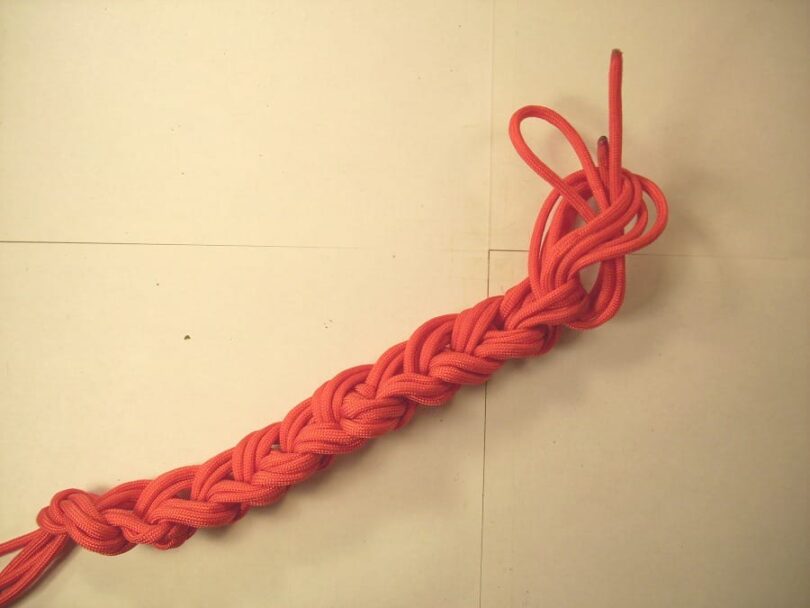
We think you’d agree that durability is very important when it comes to climbing activities like abseiling. Kernmantle ropes can however also be used for activities other than climbing outdoors.
Their key selling points are the minimal (almost zero) stretch factor of the rope and its ability to carry heavy loads under stress. The only downside we could find: It’s expensive price tag and bulky form.
Guyline Rope
These interesting ropes are very different from regular outdoors ropes and are frequently called cords rather than ropes. Their main use is for securing tents or other items to the ground. Having some extra guyline rope in your tent bag can be very useful in case you encounter strong winds.
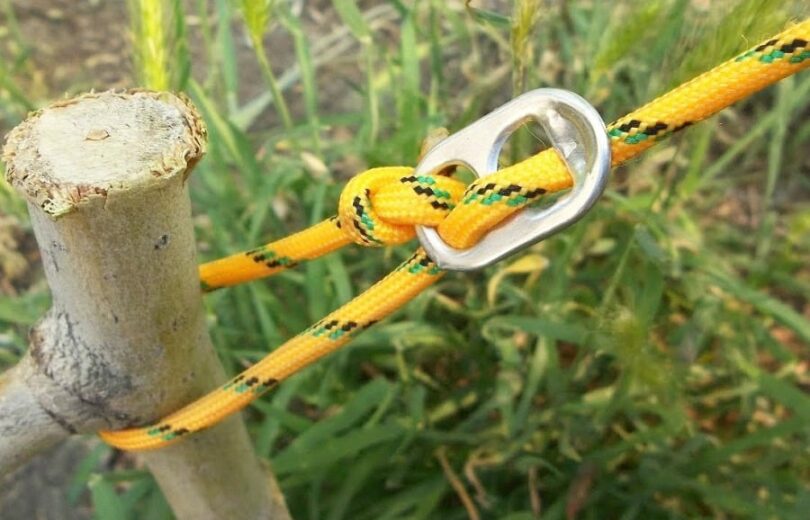
We can’t give you a lot of use ideas for this rope as they’re generally only used to ty things down in adverse conditions. They are relatively thin and strong enough to withstand the wind, but not much else. Guyline rope is perfect for keeping on hand, just in case.
Bungee Rope
Another type of rope that is commonly called “cord”, the bungee rope is extremely stretchy for a rope. It’s another name “shock cord” is commonly used when selling in the extreme sports market. The rope is made up of elastic strands in the center with an outer overlay of propylene or woven cotton.
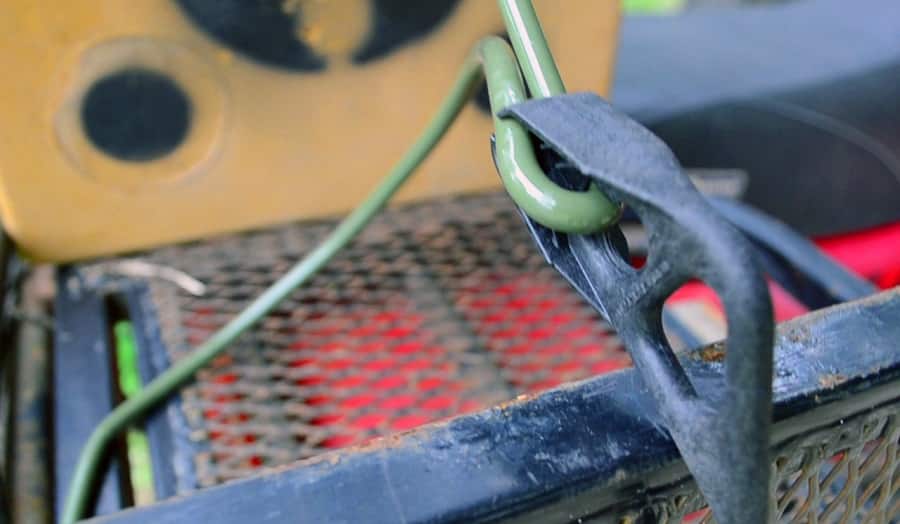
We’d recommend this as a good packing rope. It can be used to lash things onto the back of your trailer or roof and even to hold tarpaulins over things at your camp. More of a good secondary rope than a primary one, it’s still useful to have around.
It shouldn’t be your only available rope at any point though as it is definitely too stretchy for some applications, comes only in short bits, and can rot quickly when exposed to the elements. It’s for holding things together, that’s all.
Tow Strap/Rope
We considered not including this one as it’s not actually a “rope” as per say, but it is so important to have on hand in many outdoors situations that we decided it really should be in here.
Tow straps are usually sold with the purpose of towing cars or vehicles around or for wrapping items to trees. If you ever get stuck in a muddy patch with your car or really need some help tugging something along, then having a tow strap on hand will be very useful.
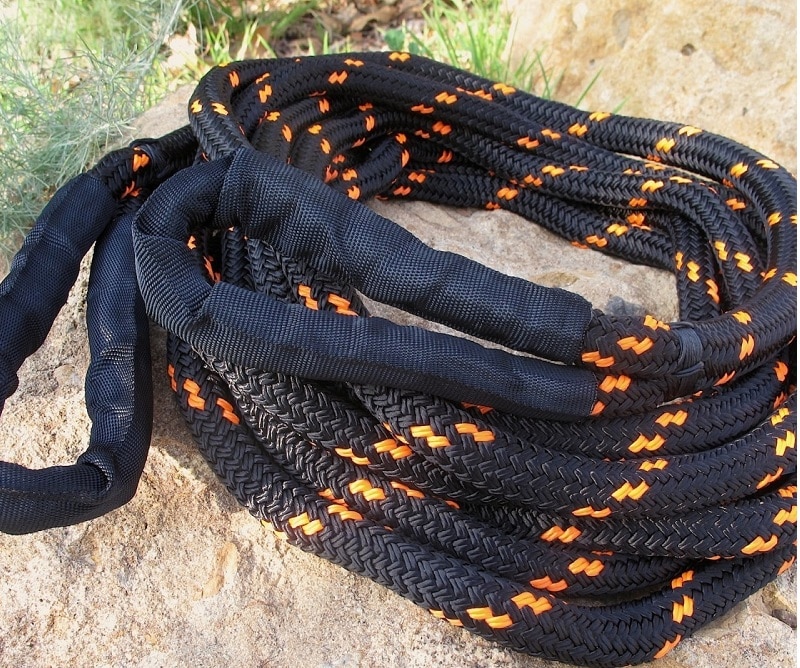
Generally, if you’re in the business of hauling around boats, large animals or other super heavy items it’s a good idea to get a strap with about a 30,000-pound limit.
These may be slightly expensive, but they are a good investment for anyone going exploring with vehicles in the bush or greater outdoors landscapes.
Paracord Rope
Our top pick for survival rope, paracord rope is strong, lightweight and durable. Also known as parachute cord this rope comes second in usage only to duct tape (whose fame we shall never diminish). We recommend it for anyone going adventuring in any form outdoors.
A decent coil of paracord rope in your kit can see you through many different situations. It was used in WWII and has since become a commonplace item in both civilian and military operations. Unlike some of the other rope, types discussed this rope doesn’t mold or rot when exposed to the elements, a very useful asset in long-term survival situations.
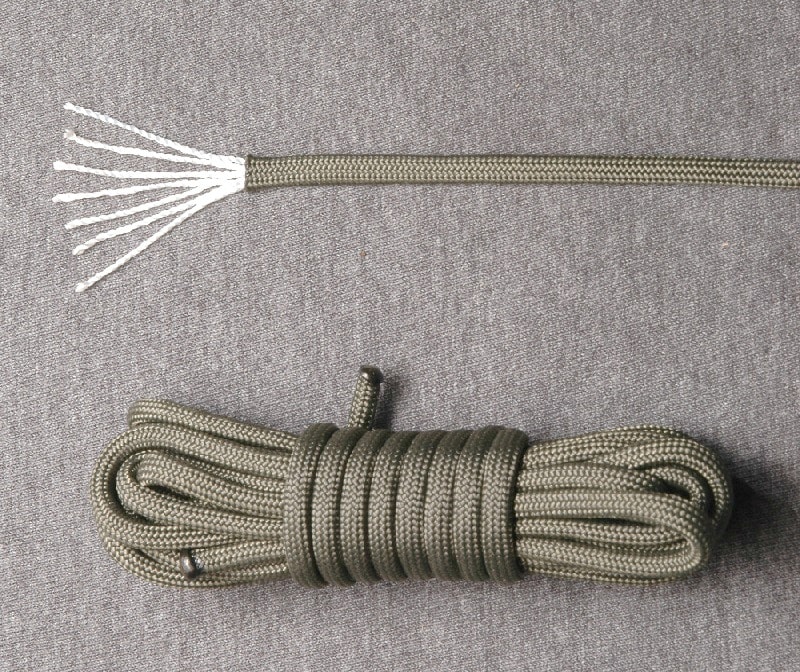
It is, unfortunately, more expensive than regular rope but is well worth the investment because it will last for years.
The rope is made from nylon (a lightweight and strong material) using the kernmantle design talked about earlier. The genuine not “made in China” version of this rope generally has between seven and nine intertwined pairs of two in its inner sheath and braided nylon as its outer layer.
As a result of its design and materials paracord rope has a resilience, flexibility, and strength second to none. (It comes with a 550-pound official strength rating to boot.)
Finally, we’ll also note that this rope can be untwined and the individual strands can be used separately depending on your situation. So really if you’re able to swallow the greater price tag, this is the best rope to get for outdoors usage.
Choosing Your Rope
It’s extremely important to have a rope in the first place, and some will always be better than none, but choosing the right kind of rope for your situation can also make your life a lot easier.
We hope this article has helped to clarify the different types out there so you can make an informed decision when stocking up your outdoors kits.
A great combination of types is the tow strap, paracord and guylines ropes as these cover most of the major areas of rope application needs that you’ll come across.
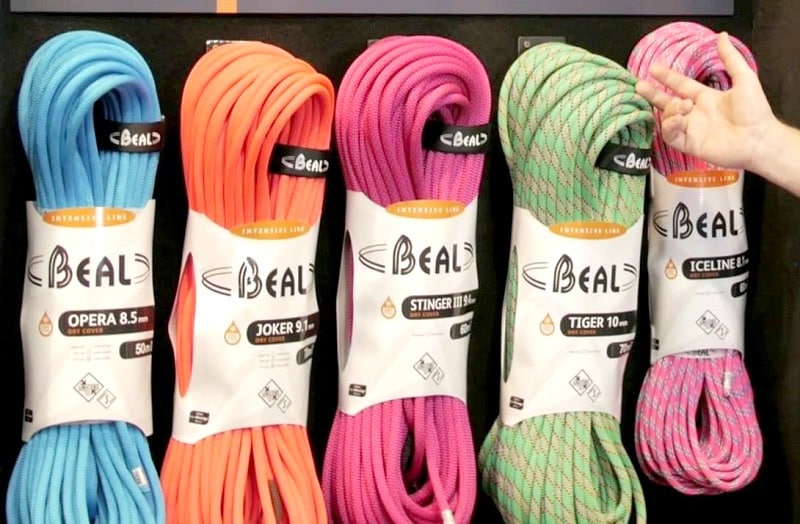
That being said, Sisal is probably the cheapest and most varied forms of rope so it’s a great option for those on a tighter budget. It’s really up to you and your intentions for the rope to decide what the best type of rope for you is. Did we forget to mention any important uses for the rope that you’re thinking of? Let us know in the comments below.
To really complete your rope knowledge, we’d say investigate and learn a few good knots. Once you’ve practiced them a couple of times you’ll be an expert and able to truly use many different types of rope to your advantage. In the end, Franklin D. Roosevelt summed it all up very well with his infamous life advice:

